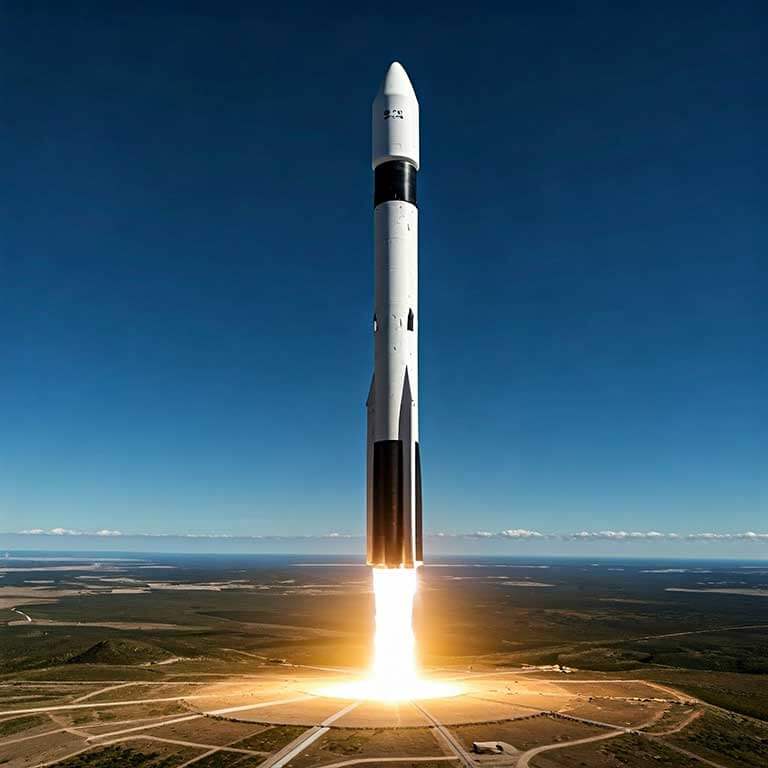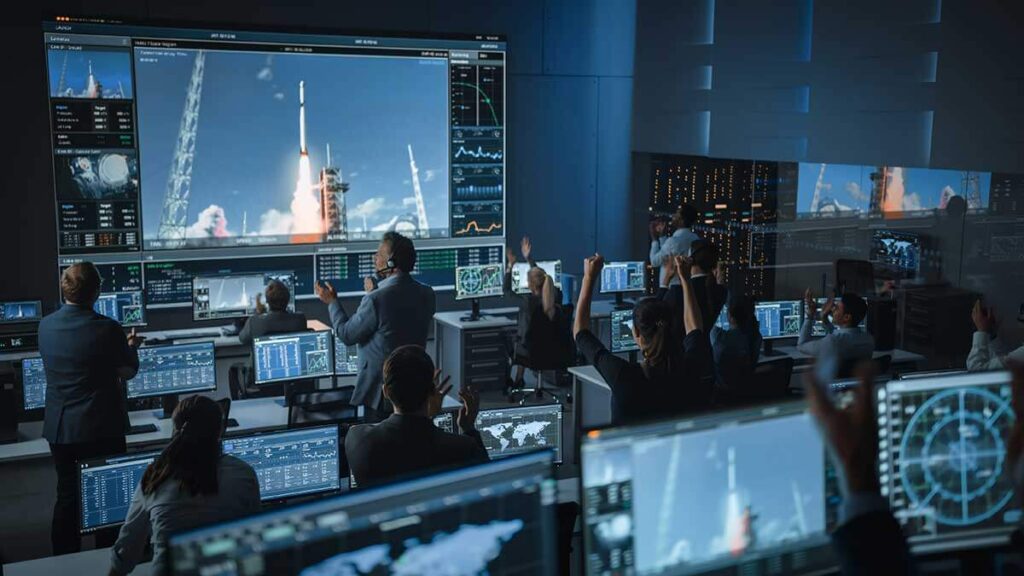In April 2024, a lot of fanfare (and later, flack) surrounded the 11 minute Blue Origin flight, carrying several famous women, “to the edge of space” and back. What many don’t realize is that just seven months prior a truly groundbreaking mission—Polaris Dawn—commanded by entrepreneur, philanthropist,and commercial astronaut Jared Isaacman, pushed the boundaries of commercial spaceflight.
Few missions have captured the imagination and ambition of humanity quite like it, before or since. Drawing from Isaacman’s comments at the Space Force Association’s Space Power conference, this article explores the mission’s significance, the rigorous training behind it and the broader insights from it that can continue shaping the future of American space leadership.
The Genesis of a New Era in Space
Jared Isaacman’s journey—from high school dropout to billionaire entrepreneur and astronaut—serves as inspiration for the next generation of space leaders and stands out as a testament to the power of vision and perseverance.
The seeds for Issacman’s space missions were sown years earlier; he had been fascinated with aviation and space as a child. Later in life, his experience as a government contractor—having founded a commercial adversary air company that provided cost-effective training for the Air Force and Marine Corps—shaped his approach to space. His around-the-world flight in 2008, coupled with an invitation to witness a Soyuz launch in Kazakhstan, convinced him that commercial spaceflight could one day become reality.
“Maybe it’s possible,” he recalled thinking, “if there is a world where you could have an opportunity to go and journey into this new frontier.” And so he made that vision a reality – and did so long before Polaris Dawn.
In September 2021, Isaacman made headlines as the commander of Inspiration4, the first all-civilian mission to orbit. That mission not only raised $250 million for St. Jude Children’s Research Hospital, but also symbolized a new paradigm where private citizens could reach the stars and contribute to causes back on Earth.

Polaris Dawn: The Mission and Its Milestones
Polaris Dawn was the first in a planned trilogy of missions under the Polaris Program, each designed to push the boundaries of commercial spaceflight. The Program was conceived as a bridge between today’s capabilities and the coming era of mass space access.
The program set out to accomplish several “firsts”: conduct a commercial spacewalk with a new, mass-producible suit design; each a high apogee of 1,408 kilometers to expose the crew to intense radiation and micrometeoroid environments and test rapid egress protocols and Starlink laser communications, which would be vital for future lunar and Martian operations.
Each of these objectives was chosen not for their spectacle, but for their utility in preparing for the next wave of missions. The data gathered on radiation exposure, suit performance, and crew health would inform the design of future spacecraft and habitats, to make space safer and more accessible for all.
Polaris Dawn actually achieved all of its intended goals and, in so doing, achieved historic milestones:
- First Commercial Spacewalk: The mission did conduct the first-ever spacewalk by a commercial crew and tested those next-generation spacesuits as well as protocols essential for future lunar and Martian exploration.
- Furthest Human Travel from Earth Since Apollo: The crew traveled farther from Earth than any human since the Apollo 17 mission in 1972, by reaching the stretch goal peak apogee of 1,408 kilometers (or about 875 miles) above the surface of the Earth.
- Advanced Research: The mission collected critical data on radiation exposure, micrometeoroid impacts and physiological effects which will inform the safety and design of future missions.
Isaacman emphasized that these achievements were not just technical triumphs but rather stepping stones toward a future where space is accessible to many. “We’re about to have this light-switch-like moment when Starship comes online,” he noted (referencing SpaceX’s next-generation vehicle). “You’re going to have lots and lots and lots of people in space at one time. That’s why we call it a light switch—everything changes.”
Inspiration4: Laying the Groundwork
The Inspiration4 mission was more than a technological feat; it was a carefully crafted statement about the potential of commercial space. Isaacman assembled a diverse crew, including Hayley Arceneaux, a childhood cancer survivor and medical officer; Chris Sembroski, an Air Force veteran who won his seat through a charity raffle; and Dr. Sian Proctor, a geoscientist and the first Black female pilot of a spacecraft. Their backgrounds underscored a central message: space is for everyone, not just career astronauts.
The mission’s public launch—announced during a Super Bowl commercial—captured the nation’s attention and energized a new generation about the possibilities of space. It also forged lasting connections with the Air Force Academy and the Space Force, as Isaacman flew second lieutenant ranks into space and presented them to new Space Force officers to ensure their first rank insignia had already orbited the Earth.
Training for the Unknown: Getting Comfortable Being Uncomfortable
Behind the glamour of spaceflight lies a grueling regimen of preparation. Isaacman described the training as a blend of classroom academics, simulator sessions and high-consequence physical challenges. “You need dynamic environments under G, where if you make mistakes, there’s a real price to pay,” he explained.
The Polaris Dawn crew spent over two years in development and training, including hundreds of hours testing new spacesuit designs and preparing for the mission’s high-risk spacewalk. This involved everything from pressurizing suits in NASA’s historic thermal vacuum chambers to riding in a reused Dragon capsule that had already proven itself in orbit.
A crucial aspect of the training involved adapting to the physiological realities of space. Contrary to popular belief, there is little correlation between motion sickness on Earth and in space. “You can be a hardcore aerobatic pilot and be really bad in space. Or someone who gets carsick on Earth can be rock solid up there,” Isaacman said. He stressed that at least 50% of astronauts experience significant discomfort during the initial days in orbit, with symptoms ranging from severe nausea to vision changes.
To prepare, the Polaris Dawn crew undertook exercises that pushed them out of their comfort zones, such as free-fall skydiving and mountain survival. The goal, as Issacman described it, was to “get comfortable being uncomfortable.” He continued, “…because you’ve got a coin-flip chance that you’re not going to be feeling great in space, but you still have to get the job done.”
Isaacman credited the confidence to open the hatch and step into the void to the thousands of engineers, technicians and visionaries who contributed to the mission. “You get proof points every single day when people show up to work, and then you see that across the industry,” he said. The ultimate validation came from surviving the harshest tests on Earth before ever leaving the planet to ensure that the crew was as prepared as possible for the unknowns of space.
The Coming Space Economy: Mining, Manufacturing and Beyond
Polaris Dawn was not just a scientific mission; it is also emblematic of the growing power of commercial innovation. Isaacman explained that while NASA’s Apollo-era achievements were backed by a budget that reached 4.5% of U.S. GDP, today’s advances are increasingly funded by private capital, yet still serve the broader public good. He advocates for private industry to “lean in and solve real problems,” investing ahead of contracts and trusting that demand will follow.
This philosophy is now evident across the commercial space sector. Companies like SpaceX, Blue Origin and Rocket Lab are investing billions of their own dollars to develop reusable rockets and new technologies. All of them are betting on a future space economy that is still taking shape.
A Booming Space Economy On the Horizon
Isaacman is bullish on the prospects of a burgeoning space economy. The falling cost of launch, Isaacman noted, is a “game changer.” It enables rapid experimentation and lowers the barrier for new entrants.
He highlighted how, for the last 60 years, the “space economy” has largely been limited to telecommunications and Earth observation satellites. However, with the cost of launch plummeting and the rise of multiple commercial providers, the economic landscape appears primed for disruption. He pointed out that new players are investing heavily, not just in launch vehicles, but in the infrastructure and technology that will enable entirely new industries to emerge.
The Next Frontier: Industry In Space
Space mining, for example, is no longer science fiction. Isaacman believes that private industry, backed by venture capital, will soon have the resources and incentives to attempt asteroid mining or lunar resource extraction. The affordability and frequency of launches mean that experimentation is finally possible at scale. “We are going to crack the code on something other than what we’ve been doing for a while.”.
As access to orbit becomes more routine, other industries besides space mining, such as manufacturing and biotechnology, seem ready to emerge. “We don’t know which one of these things it could be, or something that we’re not even imagining yet, but it will be something,” he predicted.
He likened the current moment to the early days of the cell phone, when few could have foreseen the transformative impact of mobile devices in everyone’s pocket. Today, space access is at a similar inflection point: what was once the domain of governments and billionaires is rapidly becoming accessible to innovators, scientists and entrepreneurs with bold ideas and a willingness to experiment.

Leadership in the Space: Passion, Problem-Solving, and Relentless Execution
Isaacman reflected on the inevitability of human expansion beyond Earth. Whether driven by curiosity, economic opportunity or national prestige, the next great chapter in space will be written by those willing to take risks, learn from failure and push beyond the limits of what was once thought possible.
A Word of Encouragement for Aspiring Entrepreneurs
Issacman encouraged aspiring founders to focus on solving big problems and to be “incredibly passionate” about their mission. Success, he noted, comes from building a business plan that addresses real demand, testing ideas rigorously before scaling,and committing fully to the venture—especially in its early, most vulnerable years.
He also highlighted the unique strengths that veterans bring to the commercial sector, including procedural discipline, radical ownership and a culture of continuous improvement through debriefs. These qualities, honed in military service, are invaluable in the high-stakes world of aerospace and technology startups.
The Commercial—National Security Nexus
Isaacman argued that as the space economy grows, so too will the need for protection and situational awareness. The Polaris Dawn mission, which traversed regions crowded with both active satellites and orbital debris, underscored the vital role of the U.S. Space Force and its “Guardians” in safeguarding American interests in orbit.
“America is going to lead it. And we’re going to need Guardians there on the high ground, looking out for us,” Isaacman declared. In short, the expansion of human presence in space will require both technological innovation and vigilant defense.
Next Launches Up
While there have not yet been other Polaris missions besides Polaris Dawn, Two additional Polaris missions are planned.
The Polaris Mission II will build upon the achievements of Polaris Dawn, with objectives expected to include further testing of Crew Dragon and in-space technologies. While the specific launch date has not been announced, it is planned to use a SpaceX Crew Dragon and Falcon 9, and Jared Isaacman is expected to command the mission. The mission’s objectives and schedule remain under development.
The Polaris Mission III mission is intended to be the first human spaceflight using SpaceX’s Starship vehicle. The timing is also yet to be announced, and it will depend on Starship’s readiness and successful uncrewed test flights. Mission III aims to push the boundaries of deep space human exploration, potentially including lunar or extended spaceflight objectives.
Taking the High Ground Even Higher
As for programs like Polaris Dawn, according to Issacman, the U.S. is not just participating in the new space race—it is leading it. The lessons learned from these pioneering missions will pave the way for Americans on the Moon, Mars and beyond, supported by a vibrant commercial sector and protected by the Guardians of the Space Force.
In Isaacman’s words, “We’re going to keep making the high ground higher.” The future of space belongs to those who dare to dream and to do.
By: Dawn Zoldi

